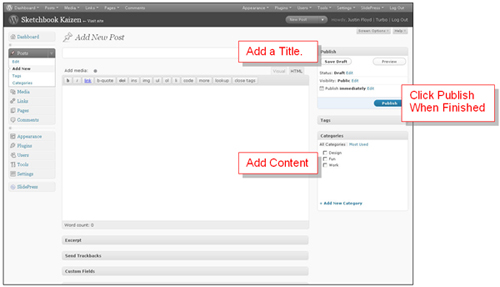
Posts are the entries that display in reverse chronological order on your home page. In contrast to pages, posts usually have comments fields beneath them and are included in your site's RSS feed.

To write a post:
The following describes features and options available to users when creating a new post.
The title of your post. You can use any words or phrases. Avoid using the same title twice as that will cause problems. You can use commas, apostrophes, quotes, hypens/dashes, and other typical symbols in the post like "My Site - Here's Lookin' at You, Kid." WordPress will clean it up for the link to the post, called the post-slug.
The big blank box where you enter your writing, links, links to images, and any information you want to display on your site. You can use either the Visual or the HTML view to compose your posts.
Allows you to see how your post will look before officially publishing it.
Shows three states for the post: Published, Pending Review, and Unpublished. A Published status means the post has been published on your blog for all to see. Pending Review means the draft is waiting for review by someone else prior to publication. Unpublished means the post has not been published and remains a draft. If you select a specific publish status and then click the Save button, that status is applied to the post. For example, to save a post in the Pending Review status, select Pending Review from the Publish Status drop-down box, and then click Save. You can see all posts organized by status by going to Manage > Posts.
To schedule a post for a future time or date, hit "Edit" in the Publish Status area of the post screen. Change the settings to the desired time and date. You must also hit the "Publish" button when you have completed the post for the post to be published at the desired time and date.
After you save your post, the Permalink below the title shows the potential URL for the post, as long as you have permalinks enabled. (To enable permalinks, go to Settings > Permalinks.) The URL is generated from your title. In previous versions of WordPress, this was referred to as the "page-slug." The commas, quotes, apostrophes, and other non-HTML favorable characters are changed and a dash is put between each word. If your title is "My Site - Here's Lookin' at You, Kid", it will be cleaned up to be "my-site-heres-lookin-at-you-kid" as the title. You can manually change this, maybe shortening it to "my-site-lookin-at-you-kid".
Allows you to save your post as a draft rather than immediately publishing it. To return to your drafts later, click the Manage tab, click the Drafts link that appears below the Manage Posts title, and then click your draft post.
Publishes your post on the site. You can edit the time when the post is published by clicking the Edit link above the Publish button and specifying the time you want the post to be published. By default, at the time the post is first auto-saved, that will be the date and time of the post within the database.
Refers to micro-categories for your blog, similar to including index entries for a page. Posts with similar tags are linked together when a user clicks one of the tags. Tags have to be enabled with the right code in your theme for them to appear in your post.
The general topic the post can be classified in. Generally, bloggers have 7-10 categories for their content. Readers can browse specific categories to see all posts in the category. To add a new category, click the +Add New Category link in this section. You can manage your categories by going to Manage > Categories.
A summary or brief teaser of your posts featured on the front page of your site as well as on the category, archives, and search non-single post pages. Note that the Excerpt does not usually appear by default. It only appears in your post if you have changed the index.php template file to display the Excerpt instead of the full Content of a post. If so, WordPress will automatically use the first 55 words of your post as the Excerpt or up until the use of the More Quicktag mark. If you use an Explicit Excerpt, this will be used no matter what.
Options to enable interactivity and notification of your posts. This section hosts two check boxes: Allowing Comments and Allowing Pings. If Allowing Comments is unchecked, no one can post comments to this particular post. If Allowing Pings is unchecked, no one can post pingbacks or trackbacks to this particular post.
Allows you to keep this particular post private so that only those with the password can read it. Be sure and write down the password and keep it in a safe place.